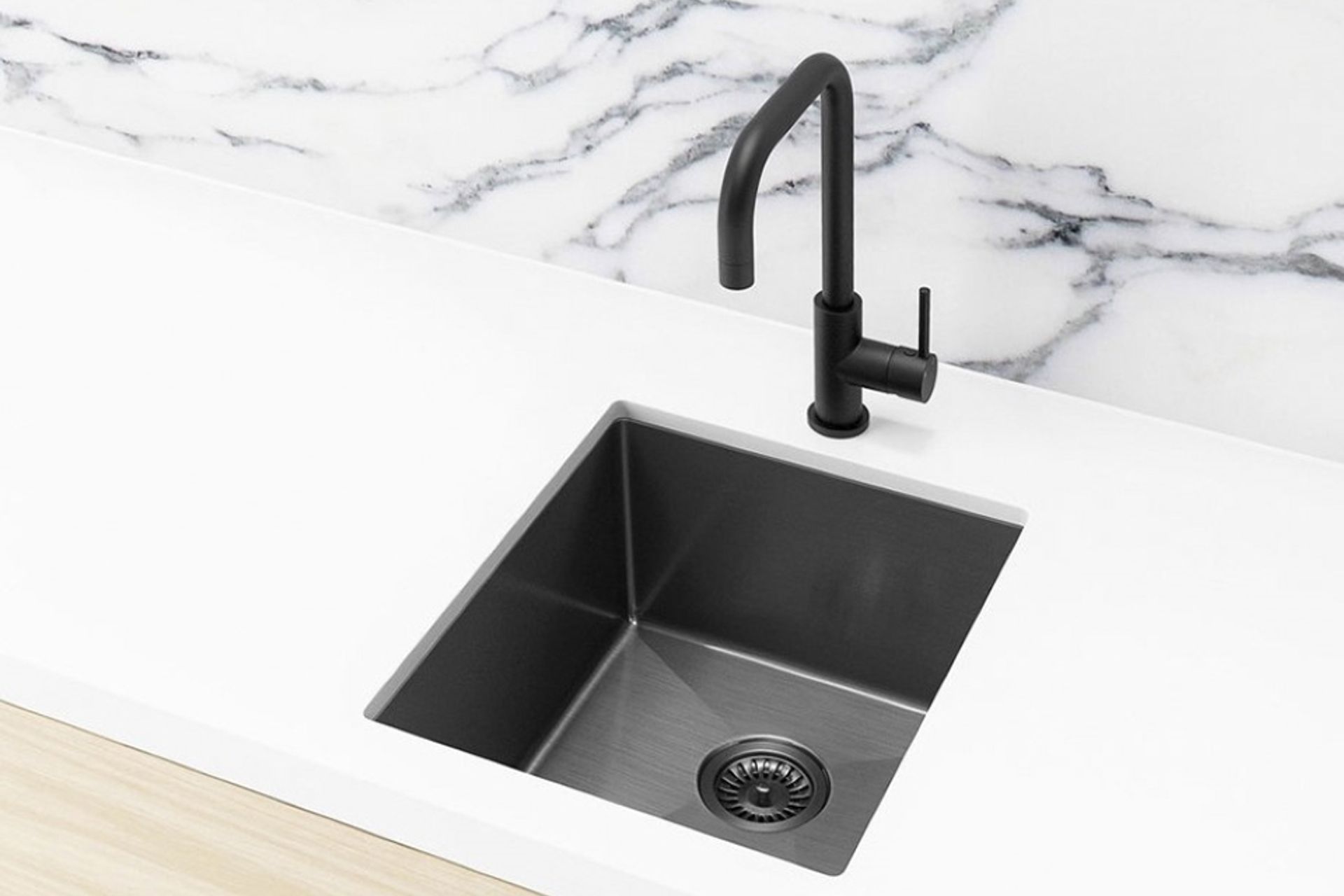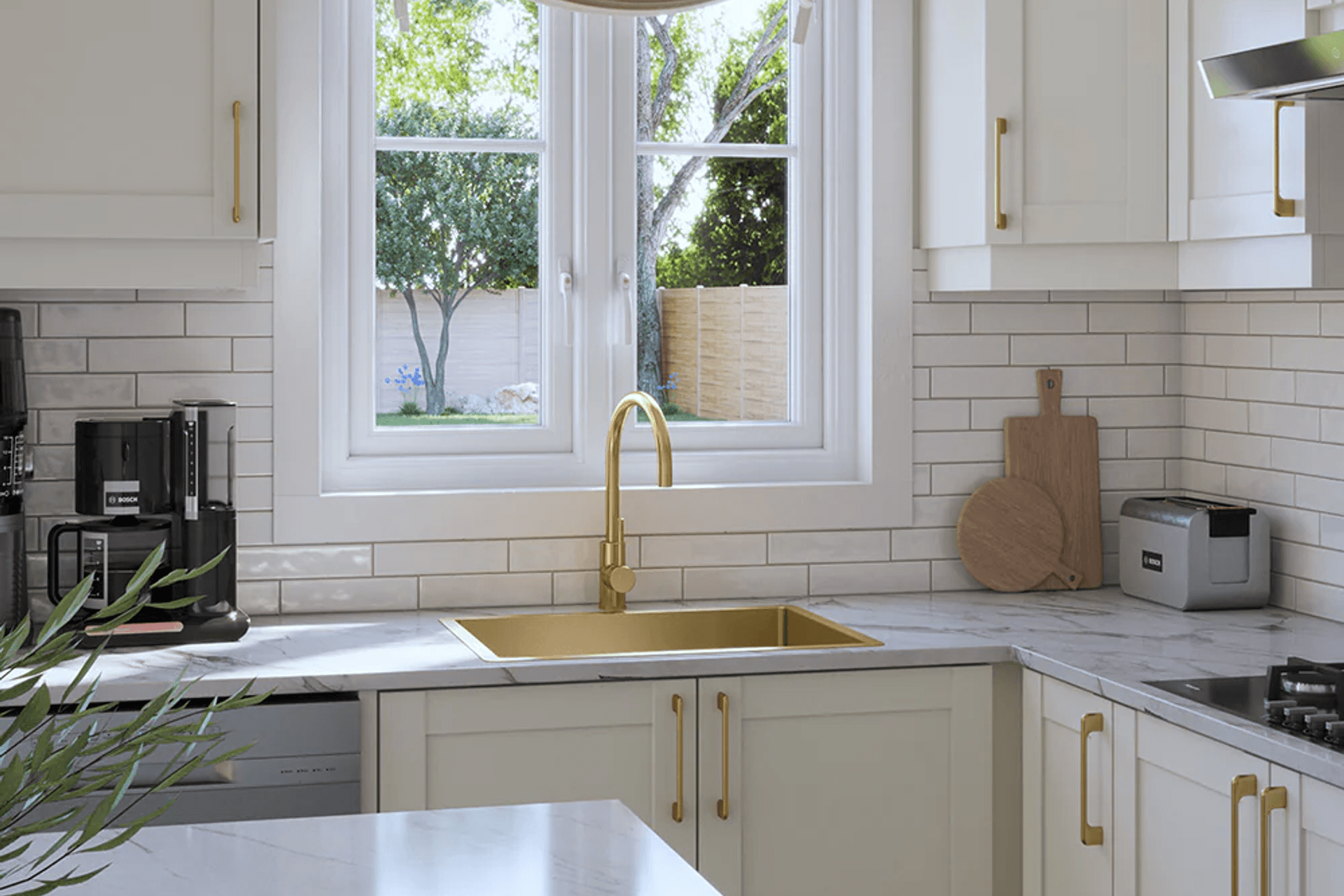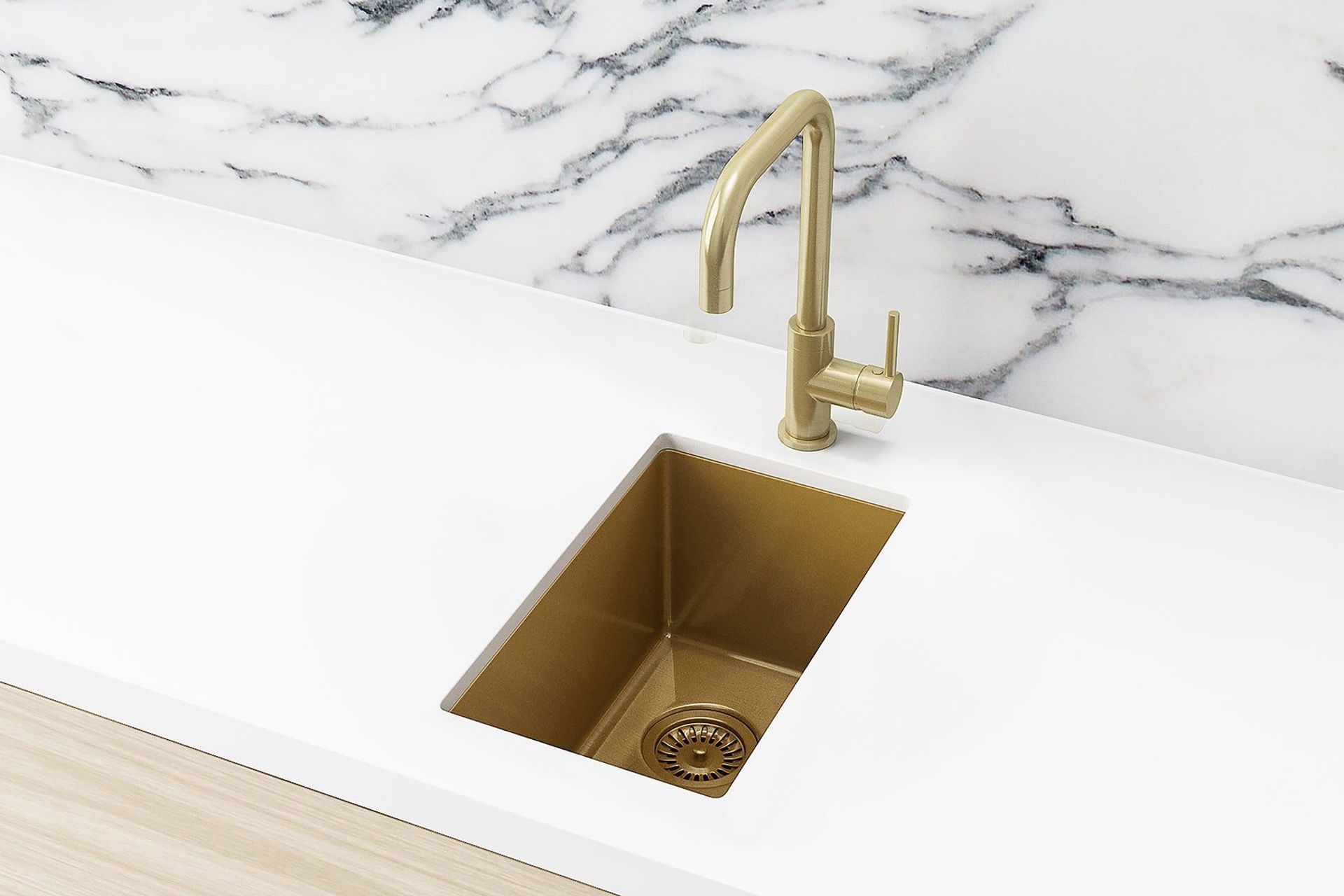An in-depth look at kitchen sink designs for modern Australian homes

Each type of kitchen sink has attributes that add to the uniqueness and aesthetic of a kitchen, adding to the overall feel and making it specific to you. Whether you are looking for practicality or flair (or a bit of both), our comprehensive guide will give you all the information you need about the most popular designs and their applications. By the end, you'll have a thorough understanding of the different kitchen sink designs on the market in Australia and be well-placed to pick one that works best for you.
Types of kitchen sink designs
1. Top mount
Top mount sinks, otherwise known as drop-in sinks, are installed from above the countertop, with the sink's rim resting on the countertop surface. This rim provides a secure and stable fit that's compatible with various countertop materials like laminate, wood, and tile. This type of sink is generally more affordable than others, making it a practical and budget-friendly option for many kitchens.
Advantages: A feature unique to top mount sinks is the exposed rim, which provides additional stability and makes them easier to install than other sink types. This design is also adaptable to many different countertop materials, including those that might not be fully waterproof.
Disadvantages: A common gripe with top mount sinks is that it can quickly accumulate grime and dirt around the exposed rim where the sink meets the countertop. This results in frequent maintenance to keep your kitchen looking pristine.
Best for: Drop-in sinks are versatile and can adapt to almost any kitchen. This adaptability makes them ideal for DIY builds, and even more so because of their easy installation and affordability.
Estimated cost: $400 and $1,000

2. Undermount
An undermount sink is installed underneath the kitchen countertop to create a seamless look where the sink blends in with the countertop. This design provides a modern and minimalist look that makes cleaning easier since no grime or food particles accumulate. Most under-mount sinks are used with solid-surface countertops like granite, marble, or quartz, which have the strength needed to support this type of sink. Ultimately, this type of sink offers a sleek visual appearance with high functionality maximising counter space.
Advantages: An undermount sink's advantage is its seamless implementation, which enhances both the functionality and appearance of your kitchen. This sink blends in with the countertop without a rim, creating a sleek appearance while simplifying cleaning.
Disadvantages: The sleek appearance of the undermount sink comes with a complex installation process that will most likely require professional assistance. Furthermore, this type of sink needs to be properly supported and sealed to prevent leaks, which is a bit more of a risk for DIY projects.
Best for: Undermount sinks are top-notch for contemporary and minimalist-style kitchens. Their seamless approach blends in with the countertop, giving it a clean, sleek look.
Estimated cost: $500 to $1,200

3. Single bowl
Single bowl sinks are one deep, uninterrupted basin that offers ample space for all of your kitchen tasks. The simplicity of this sink design provides a smooth and modern look that complements aspects of both contemporary and traditional kitchen styles. With one spacious single-bowl sink, you can easily wash large pots and pans as well as baking sheets that would normally be awkward with divided kitchen sinks. This makes single-bowl kitchen sinks an excellent option for everyday kitchen use, including intensive cooking and cleaning.
Advantages: The single-bowl sink is an uninterrupted, expansive basin that provides ample space for handling large kitchen tasks. The open design allows for easy cleaning and soaking of oversized items like baking sheets that generally fit in dual-style sinks.
Disadvantages: Single bowl sinks do not allow for the separation of tasks, making multi-tasking a bit more challenging. Without the use of a divider, it can be difficult to wash dishes and soak other items simultaneously.
Best for: Single-bowl sinks are great in almost any kitchen due to their simple design. However, they work best in small and minimalist kitchens due to their practicality and compact size.
Estimated cost: $400 to $900

4. Double bowl
Double bowl sinks use two separate basins to provide flexibility and allow them to handle kitchen chores simultaneously. This type of sink is excellent for multitasking, allowing you to wash dishes in one bowl while rinsing, soaking, and so on in the other bowl. This separation can help keep different tasks organised and efficient, making it a popular choice for busy kitchens. Double bowl sinks come in various configurations to suit the needs of any household. Its versatile functionality and practical design make them valuable additions to modern and traditional kitchen settings.
Advantages: Having two bowls with this sink design allows for easy multitasking, washing dishes in one bowl while rising vegetables or soaking cookware in the other.
Disadvantages: A common disadvantage of a double bowl sink is that each bowl is a reduced size, which can leave limited space for washing larger cookware items like baking sheets.
Best for: Double bowl sinks offer flexibility and convenience in large households, making them perfect for family homes or homes with a lot of people.
Estimated cost: $800 and $1,500

5. Bar sinks
Bar sinks, also known as prep sinks, are compact and versatile fixtures perfect for small spaces or secondary sinks in larger kitchens. Measuring smaller than standard kitchen sinks, they are perfect for drink preparation, quick rinsing of glasses, or additional prep work during cooking. Bar sinks come in various materials, including stainless steel, copper, and composite granite, allowing them to match diverse kitchen styles.
Advantages: Due to their compact size, bar sinks are ideal for handling smaller tasks, such as washing fruits, rinsing glasses, or prepping garnishes, without disrupting the kitchen space.
Disadvantages: While perfect for minor prep work and rinsing, bar sinks are unsuitable for washing large pots, pans, or baking sheets. This limitation prevents them from serving as a primary sink in a kitchen.
Best for: In large, spacious kitchens, bar sinks are great as they act as a secondary sink, providing additional workspace for food prep and clean-up and adding to the kitchen's functionality.
Estimated cost: $300 to $600

6. Butler sinks
Butler sinks, also called farmhouse sinks, are characterised by their deep, wide basins and exposed front panels. This design adds a timeless and rustic charm to the kitchen, creating a focal point in both traditional and contemporary settings. Furthermore, the spacious basin design provides ample room for washing large pots, pans, and baking sheets, which is ideal for busy kitchens. These types of sinks are designed for durability and heavy use and are made from materials like fireclay or porcelain.
Advantages: Butler-style sinks are typically custom-fitted into kitchen cabinetry, offering a seamless and integrated look that enhances the overall design of the kitchen.
Disadvantages: Some extra cleaning can be required with butler sinks since they offer an exposed front panel that is prone to smudges and stains.
Best for: Butler sinks add to the appeal of traditional-style homes by giving them a rustic charm and classic feel that pairs well with wooden countertops and vintage accessories.
Estimated cost: $800 and $1,500

7. Square sinks
A square sink is a modern and stylish addition to any kitchen, characterised by its sharp, clean lines and contemporary aesthetic. These types of sinks are typically crafted from durable materials such as stainless steel, composite granite, or fireclay, ensuring longevity and resistance to daily wear and tear. The design offers ample space for washing larger dishes and cookware while maintaining a sleek, uncluttered look on the countertop.
Advantages: A unique advantage of a square sink is its maximised usable space due to its straight, angular sides and flat bottom.
Disadvantages: Although square sinks maximise space due to their straight edges and angles, this can also make it a bit more difficult to clean this type of sink.
Best for: Square sinks are perfect for those who appreciate both form and function, as this sink brings a touch of sophistication and practicality to the heart of the home.
Estimated cost: $500 to $1,000

Kitchen sink materials to consider
When thinking about sink design, it's crucial to understand the differences between materials as each affects the aesthetics and functionality of your kitchen. The main options you’ll find in Australia are:
Stainless Steel: Durable and rust-resistant, available in finishes like brushed or polished.
Fireclay: Classic and durable, resistant to chips and scratches.
Composite Granite: Stylish and durable, heat and scratch-resistant.
Ceramic: Smooth and easy to clean, similar to fireclay but typically less expensive.
Quartz Composite: High durability and resistance to stains and scratches.
How to choose a kitchen sink
Choosing the right kitchen sink is a crucial decision that balances aesthetics, functionality, and practicality:
1. Consider kitchen size and layout
- Small kitchens: Single bowl sink to maximise space
- Large kitchens: Double bowl sink for multitasking
2. Consider the benchtop
- Ensure colour and texture harmony between the kitchen benchtop and sink for a cohesive design
- Solid surface benchtops: Ideal for undermount sinks for a sleek look
- Laminate or wood benchtops: Compatible with top mount sinks for easier installation and maintenance
3. Evaluate cooking and cleaning habits
- Frequent cooks: Larger, more versatile sinks
- Occasional cooks: Smaller, simpler sinks
4. Match personal style preferences
- Butler sinks: Deep and spacious with a classic farmhouse appeal.
- Square sinks: Modern and stylish with clean lines and a contemporary look.
5. Decide on installation type
- Top mount: Easier to install
- Undermount: Sleek, seamless look
6. Factor in budget
- Costs vary by material, design, and installation
The right sink enhances functionality and aesthetic appeal, fitting seamlessly into your routines and design vision.
Find a sink design that works for you
There are several different types of sinks on the market in Australia, each with distinct attributes that can enhance your kitchen. Finding the right one to suit your needs can be a long process, requiring much back-and-forth to decide on the one that best suits your needs. However, now that you've taken an in-depth look into the different options, you can find the sink that works best for you.
Related article: Kitchen sink sizes: tips on choosing the right fit
